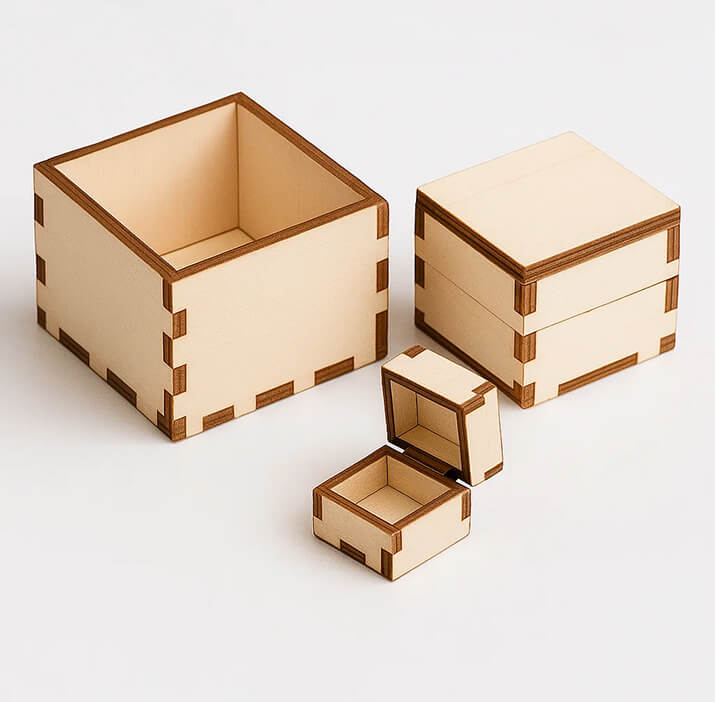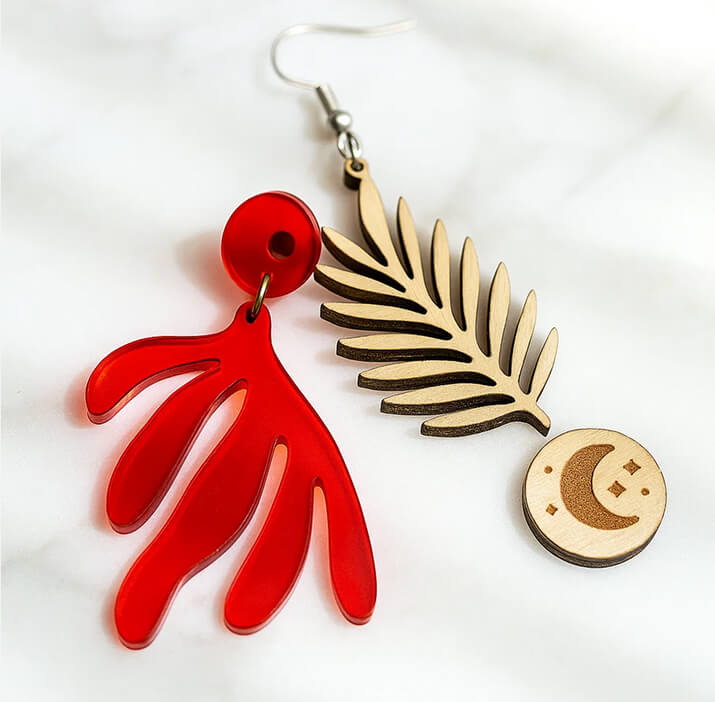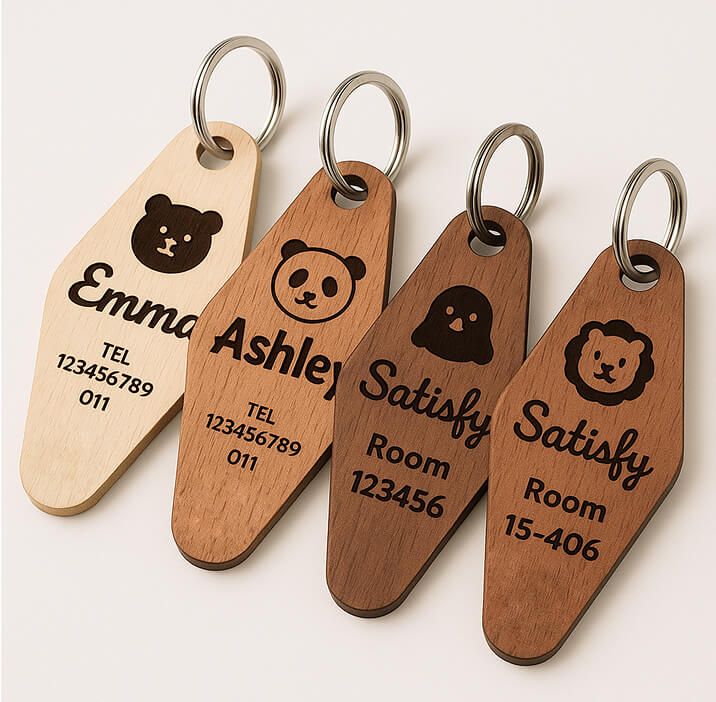![[Laser cut and engrave] Wood Inlay of Butterfly - Wall Hanging](https://image-res.xtool.com/ali-res/community/making/99d0aa55-0d30-4cb8-a4f1-7293e20c2ad0.jpg?x-oss-process=image/resize,w_1200,h_900,limit_0/interlace,1/format,webp/auto-orient,1)
Wood Inlay of Butterfly - Wall Hanging

Information
Wood inlay of a butterfly using Black Walnut, African Padauk, Yellow Heart, and Wenge. The inlay surface is 1/8” thick and glued to a backer board. The finished piece has a rubbed oil finish.
Created using xTool D1 Pro and Lightburn the inlay fit is very tight. Lightburn’s “Offset” function is used to compensate for the laser kerf.
Laser cutting time is approximately 20 minutes, assembly time approximately 2 hours.
This How-to shows you how to make a wood inlay using the xTool D1 Pro 20 watt laser. There are several options for creating wood inlays with the xTool lasers. You can use the laser to engrave a pocket for the wood and then cut the inlay pieces and place them in the engraved pocket. Or as I’m showing here you can “cut” an outline of the inlay, cut pieces to fit together in the outline, and then glue the whole piece to a substrate (backer board). The substrate can be plywood or solid wood. I’m using black walnut for the top piece and the substrate. This method is "faster" than the the engraved pocket since the laser only has to cut the outline of all the pieces.
The file of the inlay can be created in a variety of different programs including Lightburn, Visio, Inkscape, or any program that will output SVG files. I did this with a piece of clipart from vecteezy.com and then modified it to create this cut file. Each section of the cut file needs to be a “closed Vector”, so it does take some time to prepare. After creating the cut file for Lightburn the cutting the assembly is easy and like making a puzzle.
Instruction
Step1
Select Wood
You can use almost any variety of wood for this project. For this version of the butterfly project we use:
- 1 piece of 3/8 inch black walnut 6” x 12”
- 1 piece of 1/8” black walnut 6” x 12”
- 1 piece of 1/8” African Padauk approximately 6” x 8” needed
- 1 piece of 1/8” Wenge approximately 6” x 8” needed
- 1 piece of 1/8” Yellow Heart approximately 6” x 8” needed
Note: the pieces of wood shown (Paduck, Wenge, and Yellow Heart) in the photo are larger than these but the above sizes should work.
The wood shown was purchased from https://ocoochhardwoods.com/scroll-saw-lumber/ but there are many online hardwood suppliers that have similar offerings. Rockler.com also offers these types of thin exotic hardwood.
Step2
Configure Lightburn and Cut the Outline
The file, shown open in Lightburn in the photo, has two main layers. One is the outline of the Butterfly and the other has the internal pieces. The outline and each individual piece must be a closed vector.
The first photo shows the file open in Lightburn and the second shows the butterfly cut from the 1/8" Black Walnut.
For this cut only the outline of the butterfly was selected. Discard the butterfly cutout. You only need the 6" x 12" piece.
After the cut the 1/8” Black Walnut cutout was covered with blue painter’s tape on the top. The inlay will be installed upside down on the bottom and the tape will hold all the small pieces prior to gluing.
Note: the settings in the photo were adjusted before the cut. Setting for the hardwood in this project can vary with each piece of wood. The Black Walnut and Yellow Heart cut in one pass at 10 mm/second while the Padauk and Wenge cut nicely at 7 mm/second. I always do a
test cut of a small piece or scrap since this wood is expensive.
Step3
Cut Butterfly Body from Wenge Wood
Prior to cutting the Lightburn “Offset Shapes” function was used to enlarge the overall shape by 0.09 mm to compensate for the laser beam kerf (width of the beam). See photo
For this cut the outline and all the interior parts were selected. The image was rotated to align with the grain as shown in the photos. After the cut the interior and all the small dots are discarded and the Butterfly body is inserted into the main piece of 1/8” Black Walnut (the blue tape shows through. This is the bottom of the inlay layer).
The first photo shows the whole image ready for cutting. The other photos show the Offset Shapes being applied and the butterfly image moved to orient it in line with the wood grain. The final photos show the resulting cut of the Butterfly body. Note that some of the small holes feel through the honeycomb grid. We won’t use these so not a problem.
Note: Everything is flipped after cutting since we are working on the bottom side of the final image.
Also note that the Butterfly antenna broke off, which I expected since they were so thin. I inserted them individually into the 1/8" Black Walnut. They will all look like one piece in the finished work.
Step4
Cut Red Interior Body Parts from Paduak
For this cut the Padauk (red wood) was placed on the honeycomb grid and the whole butterfly image was moved off to the side in Lightburn. Copies of the larger interior parts were made and moved to the area where the wood was located. The interior parts were selected, and an offset of 0.08 mm was applied as shown in the photo to compensate for the laser kerf.
Note that the pieces were grouped to use the least amount of wood and aligned to get the grain flow as shown.
After the cut the pieces were placed in the butterfly body previously place in the walnut outline.
Step5
Cut Yellow Dots for Wings from Yellow Heart Wood
Ok, now for the tedious part
The small holes from the butterfly image were grouped and moved to an area where they could be cut out of the yellow wood. As before they were offset by 0.08 mm to compensate for the laser kerf. They were also grouped to minimize wood usage.
Since these parts are so small, they would fall through the honeycomb grid, so a piece of sacrificial wood was placed under the Yellow Heart before cutting. Sometimes the fan from the laser would blow the small pieces away so I had to recut a few. You can see the holes where the extra pieces were cut.
After these parts were cut, I use blue tape to pick them up one at a time and tweezers to place them into the holes on the main piece. This took about 45 minutes. Make sure you have a large flat clean surface for this incase you drop any of these tiny peices.
Step6
Fill Back Side of the Work
This step is optional. It turned out the Yellow Heart I had was a little thinner than the 1/8” inch walnut and the other pieces. So, to compensate I used wood filler to fill in the extra space on the back of the whole piece. By filling the back it will make all the pieces level on the front.
After the filler dried, I sanded it flat, and it was ready for gluing. This has one more advantage in that it prevents glue from pressing up between the very small gaps between the pieces.
I didn’t take of photo of the sanding process but I used an orbital sander. You could easily do this by hand. For this I used 120 grid sandpaper.
The photo shows the filler and the glue I use in the next step. The filler (Goodfilla) was purchased from Amazon and is Ebony colored. I really like this filler. It’s used in guitar inlays a lot. It dries very fast. Any good wood glue would do. I like this Tite Bond Quick and Thick glue alos because it dries after about 30 minutes of clamping.
THIS IS AN OPTIONAL STEP SINCE SOME OF MY INLAY WOOD WAS THINNER THAN THE OTHER PIECES. BUT IT CAN'T HURT.
Step7
Glue Up the Inlay with the Backer Board
In this step we take the finished inlay piece and glue it to the backer. Since the inlay piece were 1/8” thick I used a 3/8” walnut backer to give a finished thickness of ½”.
Put glue on the inlay and the backer and spread it out.
I didn't get a picture of it but spread the glue before putting the two pieces together and try to get them aligned on the edges.
Align the pieces and place them between some thicker wood for clamping.
I used C-clamps because it is simple and lets me get good even pressure. You could use some heavy weights if you don’t have c-clamps (see example photo).
Glue it up and wait for the glue to dry. In this case I gave it about 45 minutes.
If you don't get an exact alignment sand or trim the edges with a saw (see photo).
Step8
Fill Top, Sand, and Finish
Now the fun part! After the glue is dry peel off the tape to get your first look at your inlay.
I used the same filler mentioned before to apply a thin coat and press it down into any of the small remaining crack. In my piece the cracks were very small, but this really makes for a tight smooth surface.
I spread the filler with a small metal spatula. Any piece of flat metal or plastic would do.
After it dries, I start the final sanding. I sand with 120 grid sandpaper, then move to 180, and then 220 grid sandpaper. Again, I used an orbital sander, but you could easily do this by hand. After sanding I applied a couple coat of my standard Danish Oil finish. Almost any oil finish would work for this. The Danish Oil was purchased my local hardware store.




